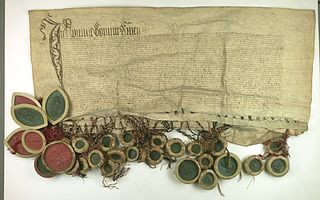
The Prussian Confederation was an organization formed on 21 February 1440 at Marienwerder by a group of 53 nobles and clergy and 19 cities in Prussia, to oppose the arbitrariness of the Teutonic Knights. It was based on the basis of an earlier similar organization, the Lizard Union established in 1397 by Chełmno Land nobles.

Warmia is a historical region in northern Poland.

Braniewo, , is a town in northeastern Poland, in the Warmian-Masurian Voivodeship, with a population of 18,068 (2004). It is the capital of Braniewo County.

Royal Prussia or Polish Prussia was a region of the Kingdom of Poland from 1466 to 1772.

The Duchy of Prussia or Ducal Prussia was a duchy in the region of Prussia established as a result of secularization of the State of the Teutonic Order during the Protestant Reformation in 1525.

Kwidzyn is a town in northern Poland on the Liwa river in the Powiśle region, with 40,008 inhabitants (2004). It has been a part of the Pomeranian Voivodeship since 1999, and was previously in the Elbląg Voivodeship (1975–1998). It is the capital of Kwidzyn County.

Warmian-Masurian Voivodeship or Warmia-Masuria Province or Warmia-Mazury Province, is a voivodeship (province) in northeastern Poland. Its capital and largest city is Olsztyn. The voivodeship has an area of 24,192 km2 (9,341 sq mi) and a population of 1,427,091.

The Prussian Homage or Prussian Tribute was the formal investment of Albert of Prussia as duke of the Polish fief of Ducal Prussia.

Lubawapronounced [luˈbava] is a town in the Warmian-Masurian Voivodeship, Poland. It is located in Iława County on the Sandela River, some 18 km (11 mi) southeast of Iława.

The State of the Teutonic Order, also called Deutschordensstaat or Ordensstaat in German, was a crusader state formed by the Teutonic Knights or Teutonic Order during the 13th century Northern Crusades along the Baltic Sea. The state was based in Prussia after the Order's conquest of the Pagan Old Prussians which began in 1230. It expanded to include at various times Courland, Gotland, Livonia, Neumark, Pomerelia and Samogitia. Its territory was in the modern countries of Estonia, Latvia, Lithuania, Poland, Russia and Sweden (Gotland). Most of the territory was conquered by military orders, after which German colonization occurred to varying effect.

Pieniężno is a town on the Wałsza River in the Warmian-Masurian Voivodeship in Poland. It is located in Braniewo County and had a population of 2,975 in 2004.

The Polish–Lithuanian–Teutonic War or Great War occurred between 1409 and 1411, pitting the allied Kingdom of Poland and Grand Duchy of Lithuania against the Teutonic Knights. Inspired by the local Samogitian uprising, the war began by Teutonic invasion of Poland in August 1409. As neither side was ready for a full-scale war, Wenceslaus IV of Bohemia brokered a nine-month truce. After the truce expired in June 1410, the military-religious monks were decisively defeated in the Battle of Grunwald (Tannenberg), one of the largest battles in medieval Europe. Most of the Teutonic leadership was killed or taken prisoner. While defeated, the Teutonic Knights withstood the siege on their capital in Marienburg (Malbork) and suffered only minimal territorial losses in the Peace of Thorn (1411). Territorial disputes lasted until the Peace of Melno of 1422. However, the Knights never recovered their former power and the financial burden of war reparations caused internal conflicts and economic decline in their lands. The war shifted the balance of power in Central Europe and marked the rise of the Polish–Lithuanian union as the dominant power in the region.
The Treaty of Kraków was signed on 8 April 1525 between the Kingdom of Poland and the Grand Master of the Teutonic Knights. It officially ended the Polish–Teutonic War.
The War of the Priests was a conflict in the Polish province of Warmia between the King of Poland Casimir IV and Nicolaus von Tüngen, the new bishop of Warmia chosen – without the king's approval – by the Warmian chapter. The latter was supported by the Teutonic Knights, by this point vassals of Poland, who were seeking a revision of the recently signed Second Peace of Toruń.

The Gollub War was a two-month war of the Teutonic Knights against the Kingdom of Poland and the Grand Duchy of Lithuania in 1422. It ended with the signing the Treaty of Melno, which resolved territorial disputes between the Knights and Lithuania over Samogitia that had dragged on since 1398.

The Roman Catholic Archdiocese of Warmia is a Metropolitan archdiocese of the Latin Rite of the Roman Catholic Church in Warmińsko-Mazurskie, Poland.

The Thirteen Years’ War, also called the War of the Cities, was a conflict fought in 1454–66 between the Prussian Confederation, allied with the Crown of the Kingdom of Poland, and the State of the Teutonic Order.

The Siege of Allenstein or the Siege of Olsztyn took place from January 1521 to February 1521, during the Polish–Teutonic War (1519–21).

The Prince-Bishopric of Warmia was a semi-independent ecclesiastical state, ruled by the incumbent ordinary of the Ermland/Warmia see and comprising one third of the then diocesan area. The other two thirds of the diocese were under the secular rule of Monastic state of the Teutonic Knights. The Ermland/Warmia see was a Prussian diocese under the jurisdiction of the Archbishopric of Riga that was a protectorate of Teutonic Prussia (1243–1466) and a protectorate by treaty of Poland - later part of the Polish-Lithuanian Commonwealth after the Peace of Thorn (1466–1772).







































